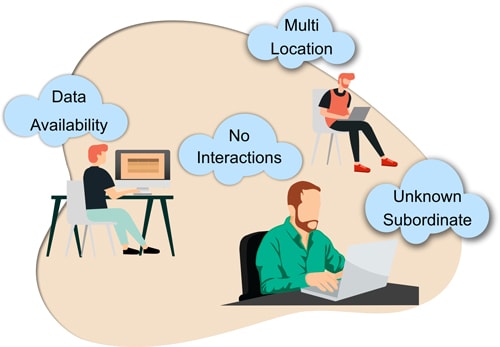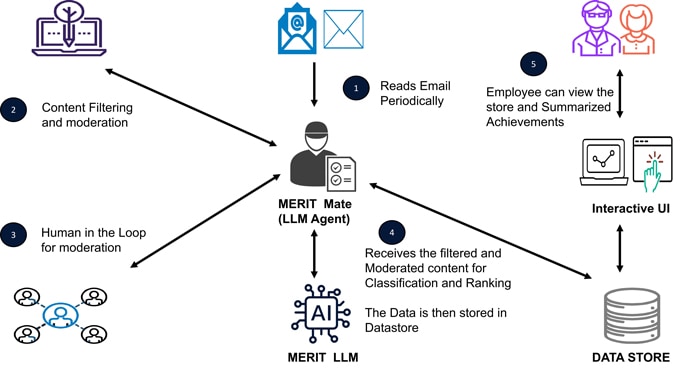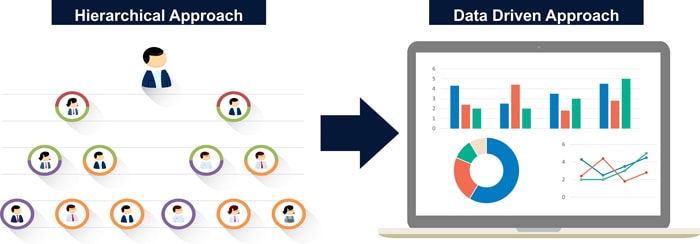Digital Workplace Services
Smart Reward and Recognition: A Generative AI Approach to Identifying and Classifying Employee Appreciation in Emails
This whitepaper explores the Automating appreciation identification in emails can revolutionize employee recognition by providing data-driven insights into employee contributions. By classifying emails and objectively assessing performance, organizations can ensure fair and effective reward allocation while safeguarding employee privacy. This process can significantly boost employee morale, engagement, and retention.
Insights
- Automating the identification of appreciation in emails can significantly boost employee recognition efforts, leading to improved morale, engagement, and retention.
- By classifying emails based on predefined criteria, the system can provide valuable insights into employee contributions, enabling more targeted and data-driven reward allocation.
- If carefully designed, the AI model can help mitigate biases in reward distribution by objectively assessing employee performance and contributions based on email content.
- Implementing robust data protection measures is crucial to safeguard sensitive PII (Personal Identifiable Information) information extracted from emails during the preprocessing stage.
Introduction
In today's fast-paced work environment, Timely recognition is critical at Company like Infosys, where employee satisfaction and engagement are key drivers of success. However, manually identifying and acknowledging employee appreciation in emails can be a time-consuming and labor-intensive task, especially in large organizations.
Also, it is not 100% transparent, due to multiple factors like no data availability, no interactions during cycle, employee working in various locations, and different teams.
And it is a time-consuming process to collate the data from multiple places and will be prone to bias by the employer. Hence The entire process is not completely data-driven and evidence-based approach which is non-transparent.
Figure 1: Data that needs to retain by management

This is where Smart Rewards and Recognition comes in – an innovative solution that leverages Generative AI to automate the process of identifying and classifying employee appreciation in emails.
By utilizing the power of Generative AI models, Smart Reward and Recognition can analyze email content, detect expressions of gratitude and appreciation, and categorize them based on sentiment, tone, and context. This innovative approach enables organizations to efficiently recognize and reward their employees' achievements, fostering a culture of appreciation and gratitude. With Smart Reward and Recognition, HR professionals and managers can focus on more strategic tasks, knowing that employee appreciation is being accurately and consistently acknowledged.
The benefits of Smart Recognition extend beyond just time savings. By providing a systematic and data-driven approach to employee appreciation, organizations can gain insights into employee opinions, identify development plans, and develop strategies to enhance employee retention and involvement . As the modern workplace continues to evolve, Smart Recognition is poised to revolutionize the way we acknowledge and appreciate employee contributions, leading to a more positive, productive, and successful work environment.
Why Generative AI (Large Language Models) over Traditional Data Models?
LLMs (Large Language Models) offer a powerful and efficient solution for data classification tasks, making them a “go to” choice among data scientists and machine learning engineer. We prefer an LLM (Large Language Models) over a traditional model for data classification due to its superior ability to understand and interpret complex language patterns.
LLMs offer several advantages over traditional models for classifying emails as appreciations. Some of them are shared below
LLMs excel at capturing the nuances of language, which is crucial for determining whether an email expresses genuine appreciation. This is not the case in traditional model which needs to train continuously. In the case do the LLM we can use the existing learning of the LLM and add our context based on our data and have fine-tuned LLM which will work to our needs.
- They can consider the entire email context, including sender-recipient relationships, previous correspondence, and subject matter, to make more accurate classifications. This is pain area in traditional models where need to create attention model based on names shared in sender list and nick name / short names referred in the mail. From our learning, Large LLMs like Open AI are already well trained to identify the relationship in such nuances in the mail which is helpful in accuracy of classification of appreciation.
- LLMs eliminate the need for manual feature engineering, data preprocessing, and model selection. In the traditional model we needed to create multi model / Algorithm to rightly classify the mail content, which LLM has reduced.
- LLMs have demonstrated better performance in Natural Language Processing tasks, and effectively handle complex sentence structures, idioms, and sarcasm, which often occur in emails.
With all these in consideration we had used LLM over traditional Models.
Solution Approach
The Smart R&R is divided to 3 major components
Figure 2: Data flow Diagram

MERIT: Multifaceted Employee Recognition Identification Trainer
This Large Language Model (LLM) is called MERIT, which stands for Multifaceted Employee Recognition Identification Trainer. MERIT is trained to analyze content shared for employee recognition purposes and assign points based on predefined categories. These categories encompass both technical and business achievements:
Some of them include:
- Delivery Excellence: This is employee Recognized for Timely and successful project delivery, Completing projects to client satisfaction and consistently delivering high-quality projects with exceptional results.
- Client Engagement: This category defines Employee's nuance in building relationships and understanding client needs and technical guidance to clients.
- Knowledge Sharing: This is where the employee has shared showcased expertise and sharing technical knowledge with peers and presenting technical topics to enhance team understanding.
- Professional Development: This is self-development of employee via Enhancing skills and knowledge through structured programs like hackathons, tech talks and developing new skills through hands-on training along with Achieving recognized certifications to enhance credibility.
- Innovation and Creativity: This is the category where the employee highlighted the below Generating novel solutions for clients., Advancing knowledge and creating an intellectual property (like Patents, White papers) for organization.
- Operational Excellence: This is the category where the employee highlighted high-quality work with measurable impact.
- Business Development: This is category where employee highlighted Supporting sales teams with technical expertise.
- Employee Recognition: This is a category where employees are recognized by an organization via multiple forums for their outstanding contribution.
- Team Engagement: This is a category were employees honor team achievements and foster camaraderie. The Long service to the organization is also recognized here.
By analyzing the content and assigning weighted points based on these categories, MERIT streamlines the employee recognition process and ensures a fair and data-driven approach to rewarding contributions.
MERITmate: Your Email Ally for Employee Appreciation
To streamline the employee recognition process and leverage the capabilities of the MERIT LLM, an intelligent email agent system can be designed with the below tasks:
- Monitoring Inbox: The agent will continuously Auto-scan all the emails the inbox of a designated email address, such as accolades@infosys.com.
- Preprocessing Email Data: Upon receiving a new email, the agent will perform defined preprocessing tasks:
- Identifying the Appreciated Employee: The agent will analyze the emails "to" list to identify the employee being recognized.
- Verifying Reporting Manager: To ensure proper recognition hierarchy, the agent will verify if the email originates from the recipient's reporting manager. Emails from unauthorized senders will be filtered out.
- Content Filtering: The agent will remove unnecessary data like email signatures, greetings, and salutations, leaving only the core recognition message for further analysis.
- Remove PII Information: This is a critical part of the data-processing which will remove any PII information which is not needed to pass on to the model.
- Interaction with MERIT LLM: The preprocessed email content, containing the details of the recognition, will be sent to the MERIT LLM.
- Reward Point Generation: MERIT will analyze the content and assign reward points based on its predefined categories (technical or business recognition) and the significance of the achievement described. The LLM will also provide justification for the assigned points.
- Validate the Response from LLM: The response from the LLM is again validated by “Human in loop” to ensure the LLM has fairly validated the content based on the summarized response for each employee.
- Database Storage: Finally, the agent will store the received email data, assigned reward points, and justification from MERIT LLM in a designated database for record-keeping and potential future use.
This system automates a sizable portion of the employee recognition process, ensuring efficiency, fairness, and data-driven reward allocation through the combined power of the email agent and the MERIT LLM. And with the “Human in the loop” at the multiple steps we can ensure that the data is validated and verified at each step.
Interactive Recognition Dashboard for Data-Driven Insights
To complement the automated recognition process and provide valuable insights, a UI (User Interface) framework has been designed. This framework connects to the database containing employee recognition data generated by the email agent and MERIT LLM. The UI offers two key functionalities:
Data Visualization: The framework features a comprehensive dashboard that displays recognition data in an easily digestible format. This includes:
- Job Band Details: Recognition data can be filtered and displayed based on employee job bands, allowing for a comparative analysis of recognition trends across various levels within the organization.
- High Performers Recognition: The dashboard can identify and highlight individuals who consistently receive high recognition points, highlighting top performers and their contributions.
- Key Differentiators: By analyzing the justification provided by MERIT for assigned points, the dashboard can identify recurring themes in high-value recognitions. This can reveal key differentiators valued by the organization and areas where employees excel.
Actionable Insights: This UI framework goes beyond simply displaying data. By providing insights into recognition trends and key differentiators, the system empowers managers to make informed decisions regarding employee development, promotion opportunities, and future recognition program strategies.
Benefits of Automating Employee Recognition with Email Agent and MERIT LLM
This innovative approach to employee recognition offers an opportunity for organization to achieve a more data driven approach for Rewards and recognition and will have multitude of advantages for both employees and organizations:
Figure 3: Hierarchical & Data Driven Approach

For Employees:
- Faster Recognition: Streamlined automation removes delays, ensuring employees receive recognition promptly, boosting morale and motivation.
- Fair and Objective System: Data-driven point allocation through MERIT LLM eliminates bias and ensures recognition reflects actual contributions.
- Transparency and Visibility: The UI dashboard allows employees to track their recognition points and understand how their achievements are valued.
For Organizations:
- Increased Efficiency: Automation saves time and resources previously spent on manual recognition processes.
- Scalability: The system can handle a large volume of recognition emails, making it suitable for organizations of all sizes.
- Data-Driven Insights: The UI dashboard provides valuable data on recognition trends, helping find high performers and valuable skills.
- Improved Recognition Culture: A streamlined and transparent system fosters a culture of appreciation, encouraging employee engagement and retention.
- Cost Savings: Automation reduces administrative costs associated with manual recognition programs.
Conclusion
To conclude, this solution development will be expanded for better accuracy and as part of future enhancement, we envision expanding the solution to:
- Connect with data sources like Teams and SharePoint for a broader perspective on shared appreciation.
- Deliver customized quarterly emails that highlight employee achievements based on their role, location, and other relevant criteria.
- Ensure accuracy by having managers review and verify the summarized achievement data for each employee.
But by combining the automation power of the email agent with the intelligent analysis of MERIT LLM, this approach creates a win-win situation for both employees and organizations, leading to a more engaged, motivated, and productive workforce.
And this smart reward and recognition system can help in improving work culture, employee morale, which in turn enhances overall organizational performance.
References
Throughout this whitepaper's preparation, information and insights were drawn from a range of reputable sources, including research papers, articles, and resources. Some of the key references that informed the content of this whitepaper include:
These references provided the foundation upon which the discussions, insights, and recommendations in this whitepaper were based.

Subscribe
To keep yourself updated on the latest technology and industry trends subscribe to the Infosys Knowledge Institute's publications
Count me in!









